Benefits of Student-Centered Learning: Important Examples
Transforming education through a student-centered approach represents a significant shift from traditional teacher-centered methods, emphasizing a more engaging, interactive, and personalized learning experience. In this educational philosophy, the classroom setting is reimagined to put students at the forefront, making them active participants in their learning journey.
This paradigm shift in teaching style, from direct instruction to learner-centered education, prioritizes the unique needs and learning styles of individual students, fostering a sense of ownership and responsibility for their own education and making the benefits of student-centered learning outweigh any reservations to utilizing this model of instruction.
By trade, I am a high school Social Studies teacher. When I would tell my students on the first day of the semester that they will never watch one PowerPoint presentation or listen to me lecture via whole-class direct instruction, they can’t wrap their heads around it.
Granted, that’s when the “Stages of Grief” (as I like to call it) begin, but that is for another post.
But the system works. I am constantly told at the end of the semester, “This was my favorite class!” and “I’ve never learned so much in a history class before”. It’s contagious and, I would argue, one of the most effective ways of getting through to our current students and the most common learning style for them.
The Evolution of the Classroom: Embracing Student-Centered Learning
I remember when I first began teaching. All I knew was lecture, PowerPoint, any questions? This is how I was taught to teach and, minus adding in some technological elements, is how people had been teaching for years. I used to think, “How can I possibly talk to each of the 34 kids in my large classes AND get all this content taken care of?”.
It was overwhelming and the expectations seemed unrealistic, yet they were getting more intense each year that passed.
In recent years, the educational landscape has seen a substantial move towards a student-centered learning environment. This approach, underpinned by an educational philosophy that values student engagement and active participation, is rapidly replacing traditional teaching methods. In a student-centered classroom, learning is no longer a passive experience dictated by rote learning and direct instruction from the front of the classroom. Instead, it’s a dynamic process where students engage in active learning, shaping their own educational journey.
There is a great article by Julie K. Brown (that can be found here) where she puts it perfectly:
“Put simply, student-centered instruction is when the planning, teaching, and assessment revolve around the needs and abilities of the students. The teacher shares control of the classroom, and students are allowed to explore, experiment, and discover on their own.”
If the thought of this just made you a tiny bit nauseous, fear not. I promise you this is ORGANIZED CHAOS and it is fabulous.
Personalized Learning Experience:
The learner-centric approach accommodates different learning styles, allowing students to learn at their own pace. This individualized attention caters to the diverse needs of students, including students of color and those from varied backgrounds, enhancing the inclusivity and effectiveness of the educational experience.
Consider a high school history class where the curriculum typically centers around lectures and textbook readings. In a student-centered classroom, the teacher introduces a unit on World War II not through a standard lecture, but by providing a range of resources: documentaries, primary source documents, historical fiction novels, and interactive online modules. Students are given the choice to explore these resources based on their learning preferences.
For instance, a visually inclined learner might gravitate towards documentaries and interactive timelines, while another might prefer delving into the personal narratives found in historical fiction. This approach allows students to engage with the material in a way that resonates with their individual learning styles, thereby enhancing their understanding and retention of the subject matter.
In a mathematics class, the student-centered approach can transform a typical algebra lesson into an engaging, personalized experience. Instead of a one-size-fits-all lecture, the teacher sets up different stations in the classroom, each designed to tackle the same algebraic concept but through different methods.
One station could involve a hands-on activity using physical objects to solve equations, another might use a computer program for visual learners to see equations in a dynamic form, and a third station could offer traditional practice problems but with varying levels of difficulty to cater to each student’s proficiency.
Students rotate through the stations at their own pace, spending more time where they need extra help. This method not only caters to diverse learning styles but also allows students to build a sense of ownership and confidence in their mathematical abilities.
In 2014, Jacob Morgan, Principal & Co-Founder of Chess Media Group, was featured in this Forbes article highlighting his book:
The Future of Work: Attract New Talent, Build Better Leaders, and Create a Competitive Organization (ad). In this article, he published the following graphic:
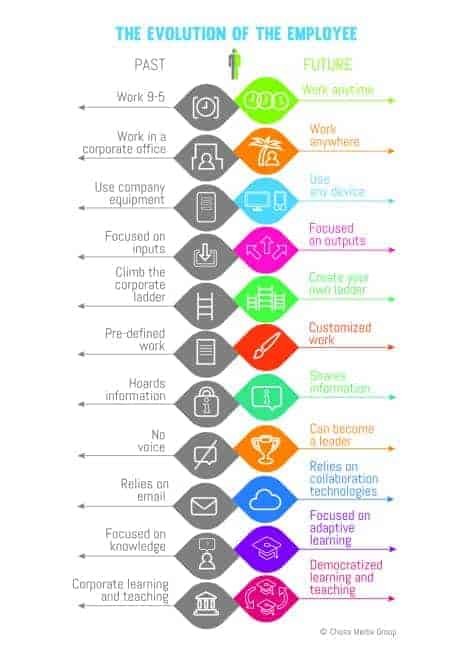
Image courtesy of Chess Media Group
Much of this graphic shows the distinct stereotype of what we have always known in the workforce, such as a 9-5 position, the work already being defined, and going to the office daily as ideas in the past.
The future ideas of an employee are already starting to become more commonplace, such as working remotely from any device, focusing on collaboration and adaptation, and work is customized to the situation at hand.
We’re currently in a place where both the past and the future are relevant, but as time progresses, more and more companies are seeing the ideas of the “future” as more sustainable for their needs and frankly, their bottom lines.
Due to this, the old way of teaching does not prepare our students for what awaits them in the real world. This is why we cannot ignore the effects of student-centered learning.
Development of Key Skills:
One of the fundamental benefits of student-centered learning is the development of critical thinking and problem-solving skills. Through methods like project-based learning and collaborative activities, students tackle real-world challenges, gaining practical experience and knowledge retention. This approach not only prepares students for higher education but also for the complexities and demands of the real world.
For instance, in a middle school science class, the teacher introduces a project-based learning unit on environmental sustainability. Students are grouped into small teams and each team is assigned a different ecosystem. Their task is to research the impact of human activities on their assigned ecosystem and propose sustainable solutions. As they delve into their projects, students actively engage in critical thinking: they analyze data, evaluate the effectiveness of current conservation efforts, and debate the socio-economic factors impacting environmental policies.
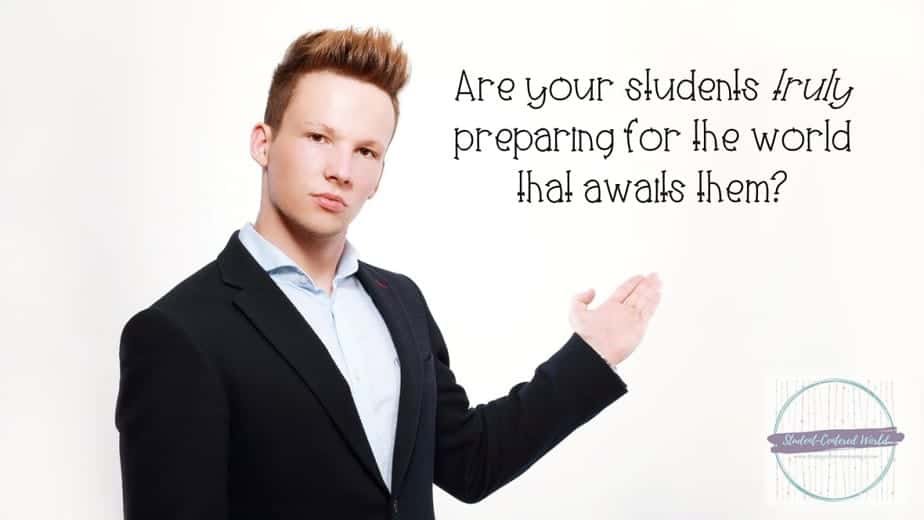
This hands-on approach not only enhances their understanding of ecological concepts but also develops their problem-solving skills as they design realistic, sustainable practices. Their final presentations, showcasing their solutions to real-world environmental challenges, demonstrate how student-centered learning equips them with practical skills and knowledge applicable beyond the classroom.
In a high school language arts class, the teacher sets up a collaborative activity that combines literature with social issues. Students are asked to read a novel that addresses a significant social topic, such as race, gender, or class. After the reading, they are tasked to work in groups to identify the core social issues presented in the book and then research how these issues are manifested in the real world. Each group must then develop a campaign or an initiative that addresses these issues, incorporating elements from the novel into their real-world solution.
This exercise not only deepens their understanding of the literature but also hones their problem-solving skills as they work collaboratively to find actionable solutions to real-life problems, preparing them for the complexities of societal issues they will encounter in their future endeavors.
Building Community and Relationships:
In a student-centered learning environment, small groups and collaborative learning foster a sense of community and strong relationships among students and between students and educators. These meaningful connections contribute significantly to a positive and supportive student experience.
Imagine an elementary language arts class where the teacher introduces a group storytelling project. Students are divided into small groups, each tasked with creating a story. One group starts the story, setting the scene and characters, and then passes it to the next group to add their twist to the plot. This cycle continues until each group has contributed to the story. Through this collaborative activity, students not only practice their writing and creative skills but also learn to listen to others’ ideas and build on them.
They learn the importance of teamwork and respecting different perspectives, fostering a sense of community in the classroom. This exercise not only enhances their language skills but also strengthens the bonds among students, creating an atmosphere of mutual respect and collaboration.
In a student-centered elementary science class, the teacher could set up a collaborative experiment on plant growth to encourage active engagement. Students are grouped and each group is given a plant to care for, but with a catch – each group makes different decisions about the care of their plant, such as the amount of sunlight, water, and type of soil. Over the weeks, the students observe and record the growth and health of their plants, discussing their observations with their group members and drawing conclusions about the best conditions for plant growth.
This hands-on, collaborative approach to learning not only deepens their understanding of plant biology but also builds a community of young scientists. As they work together, making decisions and observing the results, they develop a sense of ownership and accountability for their shared project, thereby strengthening their relationship with each other and with the subject matter.
Technology and Adaptability:
Integration of technology in student-centered schools introduces adaptive learning technologies, further personalizing the learning experience. The use of social media and online classrooms in an online learning environment enhances student engagement, offering innovative ways for students to express their student voice and participate actively in their own education.
For instance, in a middle school science class, the teacher uses an adaptive learning platform that adjusts the difficulty of science problems based on each student’s performance. As students engage with the platform, it not only caters to their individual learning levels but also provides instant feedback, encouraging students to understand concepts at their own pace. This approach not only personalizes the learning experience but also empowers students to take control of their educational journey.
Additionally, the teacher integrates social media into the curriculum, where students create posts or videos related to scientific phenomena, encouraging them to research and present information creatively and engagingly.
Another example can be seen in a high school English class, where the teacher utilizes an online classroom environment to enhance student participation. Here, students engage in literature discussions through online forums and video conferencing tools, allowing them to contribute their insights and interpretations of texts from anywhere. This method particularly benefits students who might be more reserved in a traditional classroom setting, offering them a platform to express their ideas confidently.
Moreover, the use of online platforms for project presentations enables students to showcase their understanding of literary themes and concepts through various multimedia formats. This not only fosters student engagement and creativity but also prepares them for the digital communication skills necessary in the modern world.
Professional Development and Teacher’s Role:
For educators, this shift to a student-centered approach necessitates professional development to adapt their teaching approach effectively. The role of the teacher transforms from being the sole knowledge provider to a facilitator of student-centered teaching who guides and encourages students, supporting them in taking an active role in their learning while also catering to individual student needs.

In the realm of educational development, the shift towards a student-centered approach signifies a transformative change in pedagogy. Professional development programs focused on this approach emphasize the enhancement of teaching methodologies to support and adapt to this new paradigm. The emphasis is on equipping educators with the skills to transition from traditional, lecture-based teaching to a more facilitative role. In this reimagined setting, educators learn to guide and encourage students to engage deeply with the material, fostering a more active and participatory learning experience.
This transformative approach manifests in various theoretical applications in the classroom. For instance, the concept of the teacher as a facilitator is central. In this model, the physical and instructional layout of the classroom changes to support a more interactive and student-focused learning environment. The traditional front-of-class teaching model makes way for a more dynamic setting, where students are encouraged to explore and engage with learning materials in a manner that suits their styles and paces.
This shift in the educator’s role from a primary knowledge dispenser to a supportive guide encourages greater student agency, collaboration, and ownership of the learning process, aligning with the principles of contemporary educational philosophy.
Advantages and Benefits of Student-Centered Learning:
The advantages of learner-centered teaching are manifold. In addition to fostering lifelong learners, this approach empowers students to pursue their own goals and interests. It encourages learner responsibility, ensuring students reach their full potential and experience success in their educational and personal lives.
One of the primary advantages of learner-centered teaching is that it places student learning at the center of the educational process. This approach diverges from traditional teacher-centered learning, where the educator’s knowledge directs the learning experience. Instead, in a student-centered environment, students are encouraged to take ownership of their learning.
This shift not only caters to the individual needs of students but also fosters a sense of responsibility in them. By allowing students the freedom to explore subjects in different ways and make choices about their own learning, this educational approach significantly enhances student engagement and motivation, leading to deeper and more meaningful learning experiences.
Furthermore, student-centered instruction is a powerful tool for developing critical thinking skills. Unlike traditional methods that often emphasize rote memorization, student-centered learning encourages active learners to question, analyze, and synthesize information. This style of learning is particularly effective in preparing students for real-world challenges where problem-solving and critical thinking are essential.
In student-centered classrooms, case studies, project-based tasks, and collaborative work become integral components of the curriculum, providing students with practical applications of their knowledge. This methodology not only supports academic success but also prepares students for diverse challenges in higher education and beyond.
In a study conducted by the Stanford Center for Opportunity Policy in Education (SCOPE), the data concretely shows the benefit of this model for students who are underprivileged compared to their peers. In an article by Barbara McKenna (found here), the SCORE Faculty Director Linda Darling-Hammond explains the data from this phenomenon best:
“The numbers are compelling…students in the study schools exhibited greater gains in achievement than their peers, had higher graduation rates, were better prepared for college, and showed greater persistence in college. Student-centered learning proves to be especially beneficial to economically disadvantaged students and students whose parents have not attended college.”
For what we are expected to be able to do in the classroom as teachers, this is HUGE.
By just switching a frame of mind and the way instruction is delivered, students who may struggle otherwise have the potential to actually surpass their peers in achievement. As an educator, anything that could have results like this has to be intriguing at the very least. After all, isn’t student achievement what we all wish to see in the end?
Moreover, the shift to a learner-centric approach is highly relevant in the context of degree programs and advanced studies. By moving away from the traditional teacher-centered model, students are better equipped to adapt to different styles of learning and instruction they will encounter in higher education. This flexibility is a key component of student success, as it builds a foundation for lifelong learning.
In student-centered learning environments, students not only acquire knowledge but also learn how to learn, a critical skill in an ever-evolving educational landscape. By prioritizing student choice, educators can create a learning environment where students are genuinely invested in their education, driving them toward achieving their personal and academic goals.
A Journey Towards Empowerment
The goal of student-centered learning is to create an empowering educational environment where students become lifelong learners, taking an active role in their own education and preparing for future challenges. This learner-centered environment marks a significant departure from traditional teacher-centered approaches, promising a more effective, engaging, and fulfilling educational journey for all students. By embracing this pedagogical approach, educators can ensure that the learning experience is not just about knowledge acquisition, but about developing skills, understanding, and confidence to thrive in an ever-changing world.
One of the key advantages of student-centered learning is its ability to cater to diverse styles of students, including low-income students and those with special needs, by prioritizing students’ interests and fostering self-directed learning. Unlike teacher-led instruction, which often follows a rigid structure, student-centered environments encourage inquiry-based learning, group work, and collaborative projects, allowing students to explore topics that align with student interest while developing effective communication and teamwork skills.
Research shows that this instructional approach not only enhances academic performance but also nurtures critical thinkers who are better equipped for future challenges.
Schools like XQ School have demonstrated that shifting from teacher-centered classrooms to student-centered learning approaches leads to deeper academic growth and sustained engagement. By focusing on engaging students through hands-on, meaningful activities, educators can unlock the best way to inspire a love for learning. The ultimate goal is to create classrooms where every student feels valued, supported, and motivated to take ownership of their education, preparing them not just for tests, but for life beyond the classroom.
In the end, student-centered learning isn’t just a trend; it’s a transformative shift that empowers students to become adaptable, confident, and independent learners, ready to succeed in an unpredictable future.
This article was originally published in April 2018
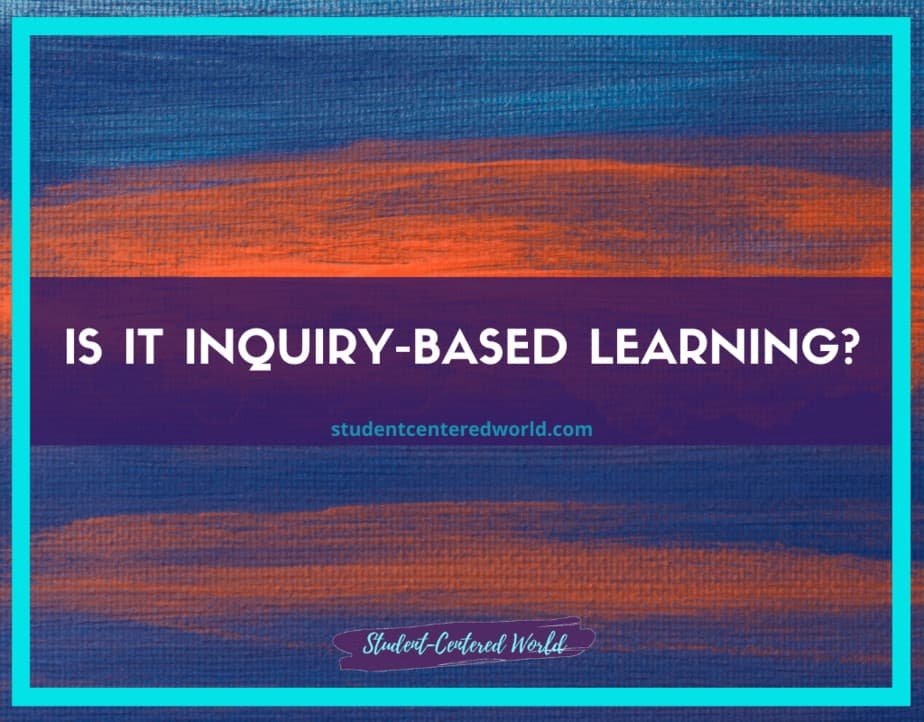



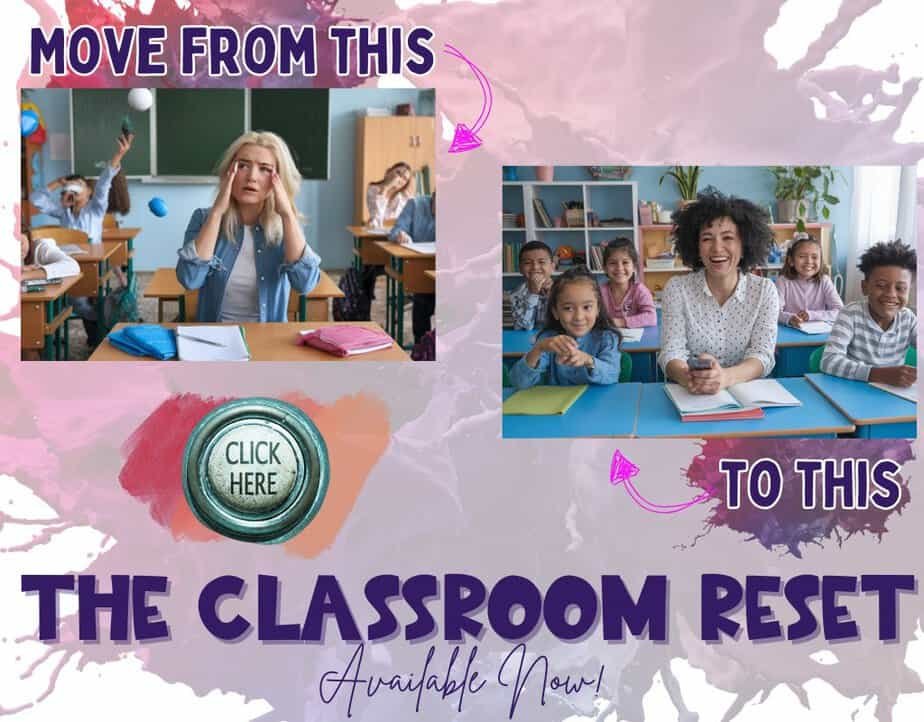
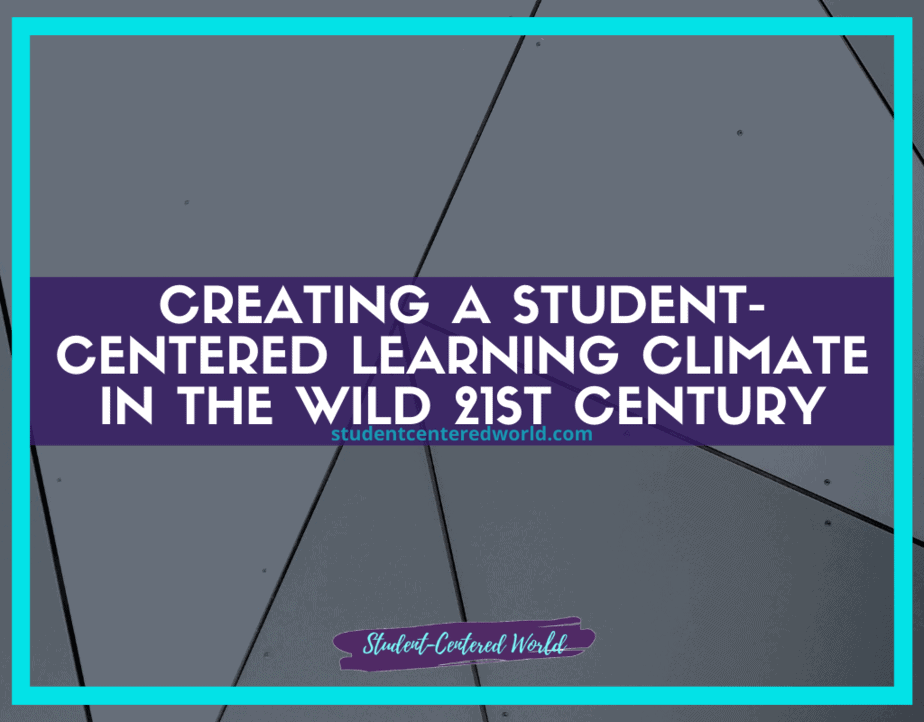


24 Comments
Lcie
I do remember the days of when the teacher stood in front of the class, lectured, and assigned the seat work! A more student-centered approach prepares students for the many distractions and challenges of adulthood. Students will gain a better understanding of their own learning styles and increases self-esteem, as well! Thanks for a well written article!
Jenn
I couldn’t agree more. Our students today are not wired to sit and listen. They need to be active!
Steve
I love the idea of student centered learning. In my opinion this is one of the best ways to ensure the students are actively thinking. Too often that “sage on the stage” you refer to spoon-feeds students information and the students simply memorize facts. Very little learning and thinking happens because students are simply doing what the teacher told them to do.
Jenn
Yes. We are no longer in the industrial model in society where people need to learn how to rinse and repeat.
Laura
This is such an interesting article! As a special education teacher, I am constantly exploring new ways to engage my students and help them reach their fullest potential. This was very informative. I have a lot of student-centered learning in my K-5 resource room now, but I’d love to hear about more potential lessons and activities!
Jenn
Awesome! My focus for the next several months is to rock Teachers Pay Teachers. Make sure you sign up for our mailing list to keep up to date with what we have 🙂
TheSocialEmotionalTeacher
Wow! I found this post to be so helpful in understand exactly what student centered learning is and why it is so important. Thank you for inspiring me to dig deeper into this topic and how I can apply it to my own teaching. I can’t wait to continue to learn more and will be back for more ideas and strategies!
Jenn
Thanks for your kind words! Once you make the switch, you won’t regret it.
Shannon Olsen
I wholeheartedly agree with this! Students learn more by discovering and doing than by being told. It is much different than the way we were taught as students, but a shift that more should definitely consider!
Jenn
I think the biggest hang-up with teachers who don’t want to make the switch is because it’s not the way they were taught. Our students are very different than any generation before them, and our teaching needs to reflect that.
Melissa Qualle
I totally agree!
As a “seasoned” educator, I find this method the most efficient and beneficial way to meet all student needs. The Student-Centered Learning environment is truly differentiating!
Jenn
Yes! It naturally differentiates for every single student in the classroom when implemented properly. What other method of teaching can do that?
Casie
I agree that student-led teaching is more beneficial. We use it at home when our children are infants; watching their interests and using them to build sounds, words, teach shapes, letters, colors, etc. As parents, we know that what interests our child is a great motivator to learn. This concept doesn’t change as they get older. I appreciate your research and the data you included. This is a great article!
Jenn
Exactly…and when they’re little is when they’re learning so much! We need to cultivate that and keep it going throughout their school years.
Nicole
I so agree with everything that you said here! As educators we need to focus on student needs and let the lessons be interactive and engaging. We also need to let students take control too. While teaching I look for things they enjoy and things they need to learn and merge it together to really speak to and inspire my students.
Jenn
One of the aspects of student-centered teaching to remember is to be flexible with your lesson plan. If you see something working for your students, run with it! If you don’t, change it. How else will your students find their way to complete engagement, right?
Dawn
Student centered learning is so important. I can’t wait to check out your book recommendations about it too!
Jenn
Thank you for your kind words! I have a ton of teaching books I love listed on my Amazon storefront. Be sure to check it out!
Ivana
Thanks for writing such a well-researched and thoughtful article – definitely needed when it can be difficult to actually put student-centered learning into practice! I teach 1:1 online ESL lessons and while the format makes it easier to put the student first, there’s still sometimes the pressure to finish the slides, etc. despite the student’s level. I’ll have to brainstorm more on how to put their needs before just covering every question on every slide!
Jessica
A student centered learning environment is so pivotal to the learning process! I remember, as a child, sitting in rows and being assigned worksheet after worksheet. I’m so glad we’ve moved out of that phase in education!
Jackie
What a wonderful article. I totally agree we need to let our students take a larger role in the learning process. When we create student-centered lessons we allow students to learn more and teach each other. Our job as teachers should be to push students into the driver’s seat and we need to ride along and help them if they need it.
Leslie
I love this! I will definitely put into practice giving my students a voice! Thanks so much for sharing.
Debora
Making my room student centered was always a must because kindergarten kiddos function best that way. Voice and choice makes a huge difference! Thanks for the book recommendations! I haven’t read those yet!
Tara
Switching to student-centered learning in my classroom has allowed me to differentiate my instruction to better meet the needs of all my students. I’m able to get to know them and use their strengths and interests to make my lessons more engaging. This is a wonderful post and will hopefully encourage other teachers to make the switch.